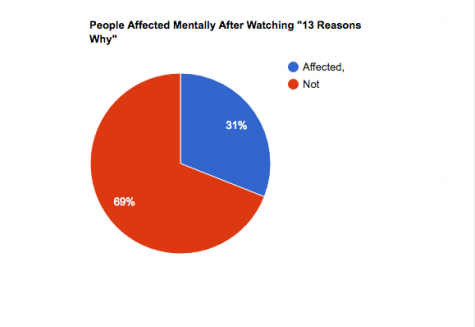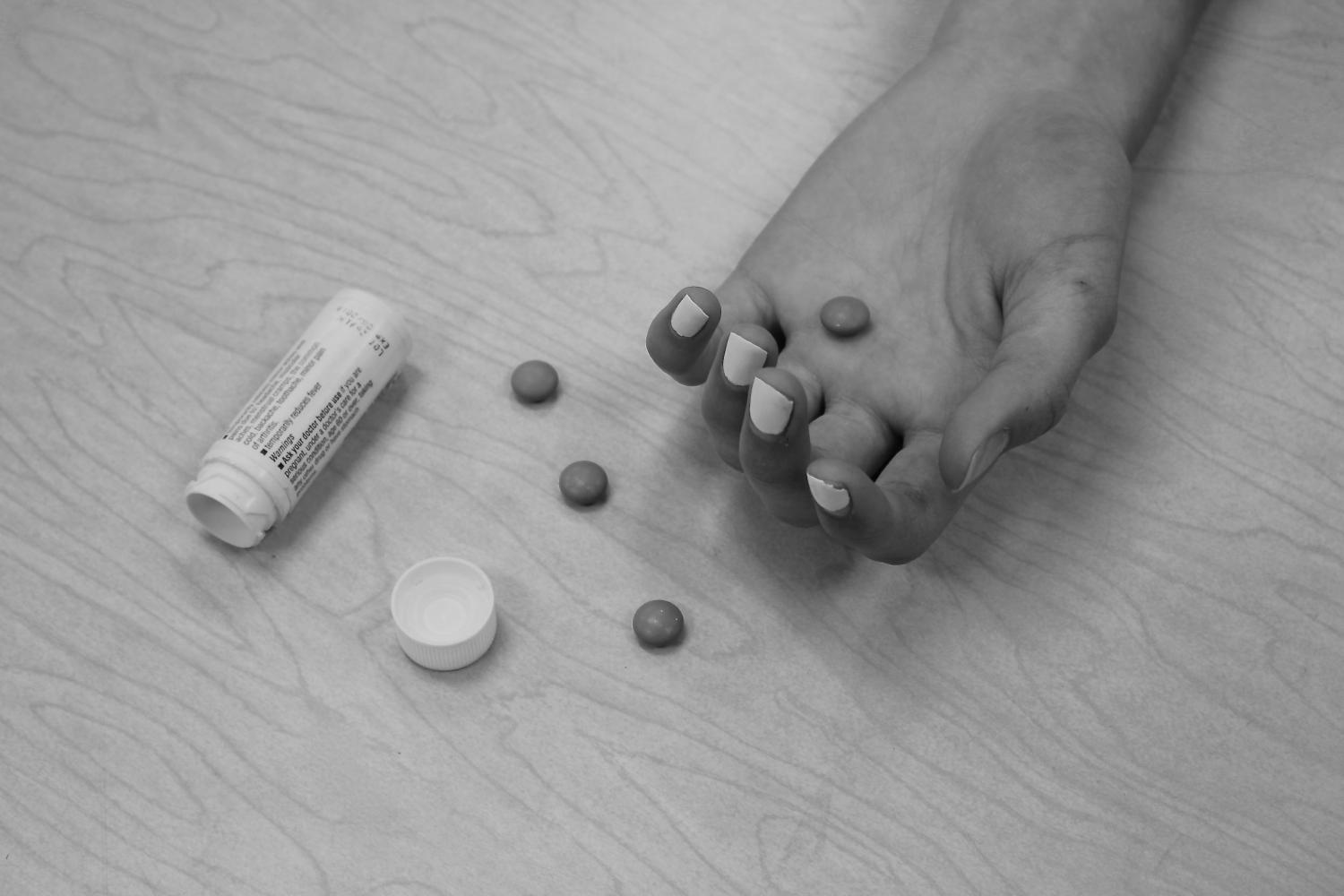Glamorizing suicide
May 11, 2017
Suicide is the second leading cause of death in the United States. Each year 44,193 Americans die by suicide, for every suicide, 25 attempts, according to the American Foundation for Suicide Prevention. It is causing the US $51 billion annually.
As our world develops, economically and technologically, the risk of suicide drastically rises. The media, ranging from Instagram and Snapchat to Netflix and Hulu, affects the lives of kids who have accessibility to those media platforms. According to the Cyberbully Hotline, 20% of kids cyberbullied think about suicide, and 1 in 10 attempt it. 100 to 200 teens died in clusters, and in many cases, the additional victims were friends of the teen or identified strongly with something about his story reported in the news, a creative writing lit mag said.
On March 31 2017, Netflix released the 13-episode show called “13 Reasons Why” created by Brian Yorkey based on the novel published by Jay Asher in 2007. The show surrounds Hannah Baker, the protagonist, and how her life turned quickly dark when she moved to Crestmont and started High School. Each episode is centered around a different character and how their actions caused Hannah to commit suicide. Each character received 13 tapes recorded by Hannah before she died. They explain how their actions affected her and her decisions. Not only did students from the school received these, but so did teachers. Although all characters received the tapes, the show is focused on Clay Jensen, a young boy who worked with Hannah.
After the release of the show, Netflix and the creators of the show received a tremendous amount of backlash from the public. Parents, teachers, and schools were concerned about how the show will settle with their students and younger audiences. After the show erupted with popularity, people took to the internet to express their deep concerns about the shows graphic content. The show is “remarkably dangerous,” especially for younger audiences, according to Harold S. Koplewicz, President of the Child Mind Institute.“It’s not only the content, but the message it gives, which is that there is no help and that suicide is glamorous and effective,” Koplewicz said. “It’s a false message, and it has a contagious effect.” Koplewicz said. Decades of research has shown that when one teen commits suicide, there can be clusters, where more suicide follows. This is one thing that has happened in the recent month of the shows appearance. “This program is coming into living rooms with kids, who seem cool with it, and are very witty, and they are giving the message of ‘once you are dead, you can get revenge on the people who were mean to you,’” Koplewicz said.
To try and understand the number of Homestead student watching the series, the Highlander staff surveyed 100 freshmen through seniors: 63 people watched the show, and 37 didn’t. Out of the 100 students, 31 felt the show impacted their mental health while 69 felt it didn’t or didn’t have an answer. This showed that more than half of the surveyors had watched the show. The obvious popularity of the show is concerning many parents and staff members.


On April 27, the Mequon Thiensville School District send out an email concerning the new show. “When a popular culture phenomenon emerges that holds the potential to cause emotional or physical harm to children, we believe it is our obligation to communicate with our parents and families regarding the situation,” the email stated. “We recognize that watching “13 Reasons Why” may initiate positive family conversations about treating other with respect and kindness, and how to respond to bullying ot conflicts with peers. However, we find the overarching message of the series is that Hannah’s circumstances related to her school life and relationships with peers contributed to her decisions to commit suicide. That message holds the potential to limit young people in their consideration of the options and resources available to them if they face similar feelings or circumstances. It is a troubling message for any viewer, regardless of age,” it said. As well as giving numerous sources for getting help like guidance counselors and hot lines.
Other schools felt that these steps were also necessary. At Westland Middle School in Bethesda, Md., they sent an email to parents warning them about the show, and encouraging them to talk to their children about it. Likewise, Hamilton Southeastern Schools in Fishers, Ind., also sent an email with a warning from the National Association of School Psychologists, or NASP about the show.
Vulnerable teens may self-identify with the main character and her experiences with bullying and depression, according to James Bray a family psychologist and an associate professor at Baylor College of Medicine. Koplewicz encourages all parents to watch the show so they are aware of the content and the show’s portrayal of youth suicide. He said parents should prevent younger children from watching it, and watch it with older ones who may see it on their own. “For parents with teens saying, ‘I absolutely want to see this -show’… parents have to watch it with them, and talk to them about it,” he said, “You have to provide the parental warning, this is dangerous material.” Suicide rates in the US, particularly for teen girls, are climbing. Half of parents say they worry their child is being bullied or struggling with anxiety or depression—a concern that is especially pronounced amongst racial minorities.
Some mental health experts say the show could pose health risks for certain young people, such as those who have suicidal thoughts. Others suggest the show provides a valuable opportunity to discuss suicide risk with young people, as well as teaching them how to identify warning signs of depression or suicidal thoughts among their peers, CNN said.
Netflix is now adding more “triggering warnings” before every episode to warn the viewers about the content within. “While many of our members find the show to be a valuable driver for starting important conversation with their families, we have also heard concern from those who feel the series should carry additional advisories,” Netflix stated in an article by Variety Magazine.
“Moving forward, we will add an additional viewer warning card before the first episode as an extra precaution for those about to start the series and have also strengthened the messaging and resource language in the existing cards for episodes that contain graphic subject matter, including the URL 13ReasonsWhy.info — a global resource center that provides information about professional organizations that support help around the serious matters addressed in the show,” Netflix stated.
Even recently, Netflix confirmed the release of a second installment of the show. The season two renewal arrives at the beginning of Mental Health Awareness Week, May 8-14. Season two will consist of another 13 episodes which will debut on Netflix in 2018 under the guide of showrunner Brian Yorkey. The series stars Katherine Langford as Baker, Dylan Minnette, Mark Pellegrino and Kate Walsh. “We stayed very true to the book. That’s initially what Jay Asher created, a beautifully tragic, complicated yet suspenseful story, and I think that’s what we wanted to do,” Selena Gomez, one of the directors of 13 Reasons Why, said in the same article.
If you feel like you, or a friend, need additional resources or information about suicide and mental health, feel free to check out the following website or confide in a trusted adult or counselor.
Suicide Prevention Hotline: Call 1-800-273-8255
http://www.13reasonswhy.info/#usa
National Suicide Prevention Lifeline ‘1-800-273-TALK (8255)’
Text: 741741
